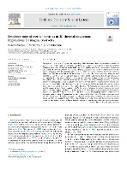| dc.contributor.author | Patočka, Vojtěch | |
| dc.contributor.author | Tosi, Nicola | |
| dc.contributor.author | Calzavarini, Enrico | |
| dc.date.accessioned | 2023-01-23T15:10:41Z | |
| dc.date.available | 2023-01-23T15:10:41Z | |
| dc.date.issued | 2022 | |
| dc.identifier.uri | https://hdl.handle.net/20.500.14178/1675 | |
| dc.description.abstract | The dynamic behaviour of crystals in convecting fluids determines how magma bodies solidify. In particular, it is often important to estimate how long crystals stay in suspension in the host liquid before being deposited at its bottom (or top, for light crystals and bubbles of volatiles). We perform a systematic 3D numerical study of particle-laden Rayleigh-Benard convection, and derive a robust model for the particle residence time. For Rayleigh numbers higher than 107, inertial particles' trajectories exhibit a monotonic transition from fluid tracer-like to free-fall dynamics, the control parameter being the ratio between particle Stokes velocity and the mean amplitude of the fluid velocity. The average settling rate is proportional to the particle Stokes velocity in both the end-member regimes, but the distribution of residence times differs markedly from one to the other. For lower Rayleigh numbers (< 107), an interaction between large-scale circulation and particle motion emerges, increasing the settling rates on average. Nevertheless, the mean residence time does not exceed the terminal time, i.e. the settling time from a quiescent fluid, by a factor larger than four. An exception are simulations with only a slightly super-critical Rayleigh number (similar to 104), for which stationary convection develops and some particles become trapped indefinitely. 2D simulations of the same problem overestimate the flow-particle interaction - and hence the residence time - for both high and low Rayleigh numbers, which stresses the importance of using 3D geometries for simulating particle-laden flows. We outline how our model can be used to explain the depth changes of crystal size distribution in sedimentary layers of magmatic intrusions that are thought to have formed via settling of a crystal cargo, and discuss how the microstructural observations of solidified intrusions can be used to infer the past convective velocity of magma. (c) 2022 Elsevier B.V. All rights reserved. | en |
| dc.language.iso | en | |
| dc.relation.url | https://doi.org/10.1016/j.epsl.2022.117622 | |
| dc.rights | Creative Commons Uveďte původ-Neužívejte dílo komerčně-Nezpracovávejte 4.0 International | cs |
| dc.rights | Creative Commons Attribution-NonCommercial-NoDerivativeWorks 4.0 International | en |
| dc.title | Residence time of inertial particles in 3D thermal convection: Implications for magma reservoirs | en |
| dcterms.accessRights | embargoedAccess | |
| dcterms.license | https://creativecommons.org/licenses/by-nc-nd/4.0/legalcode | |
| dc.date.updated | 2023-10-02T06:15:06Z | |
| dc.subject.keyword | Rayleigh-B?nard convection | en |
| dc.subject.keyword | inertial particles | en |
| dc.subject.keyword | residence time | en |
| dc.subject.keyword | crystals in magma | en |
| dc.subject.keyword | particle-laden flow | en |
| dc.relation.fundingReference | info:eu-repo/grantAgreement/UK/COOP/COOP | |
| dc.date.embargoStartDate | 2023-10-02 | |
| dc.date.embargoEndDate | 2024-05-30 | |
| dc.type.obd | 73 | |
| dc.type.version | info:eu-repo/semantics/acceptedVersion | |
| dc.identifier.doi | 10.1016/j.epsl.2022.117622 | |
| dc.identifier.utWos | 000812307000008 | |
| dc.identifier.eidScopus | 2-s2.0-85131460822 | |
| dc.identifier.obd | 619761 | |
| dc.identifier.riv | RIV/00216208:11320/22:10452102 | |
| dc.subject.rivPrimary | 10000::10500 | |
| dcterms.isPartOf.name | Earth and Planetary Science Letters | |
| dcterms.isPartOf.issn | 0012-821X | |
| dcterms.isPartOf.journalYear | 2022 | |
| dcterms.isPartOf.journalVolume | 591 | |
| dcterms.isPartOf.journalIssue | May | |
| uk.faculty.primaryId | 116 | |
| uk.faculty.primaryName | Matematicko-fyzikální fakulta | cs |
| uk.faculty.primaryName | Faculty of Mathematics and Physics | en |
| uk.department.primaryId | 1276 | |
| uk.department.primaryName | Katedra geofyziky | cs |
| uk.department.primaryName | Department of Geophysics | en |
| dc.description.pageRange | nestránkováno | |
| dc.type.obdHierarchyCs | ČLÁNEK V ČASOPISU::článek v časopisu::původní článek | cs |
| dc.type.obdHierarchyEn | JOURNAL ARTICLE::journal article::original article | en |
| dc.type.obdHierarchyCode | 73::152::206 | en |
| uk.displayTitle | Residence time of inertial particles in 3D thermal convection: Implications for magma reservoirs | en |

